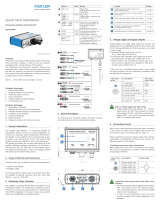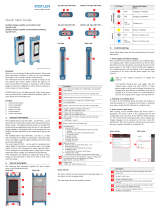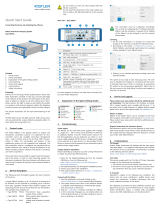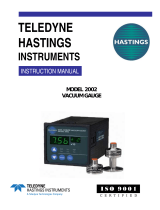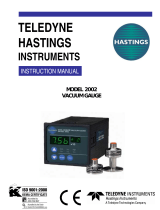Page is loading ...

Instruction
Manual
Piezoresistive
Amplifier
Type 4665B1
Type 4665B2
4665B_002-699e-06.14

Instruction
Manual
Piezoresistive
Amplifier
Type 4665B1
Type 4665B2
4665B_002-699e-06.14


Foreword
Foreword
Thank you for choosing a Kistler quality product
characterized by technical innovation, precision and long
life.
Information in this document is subject to change without
notice. Kistler reserves the right to change or improve its
products and make changes in the content without
obligation to notify any person or organization of such
changes or improvements.
©2014 Kistler Group. All rights reserved. Except as
expressly provided herein, no part of this manual may be
reproduced for any purpose without the express prior
written consent of Kistler Group.
Kistler Group
Eulachstrasse 22
8408 Winterthur
Switzerland
Tel. +41 52 224 11 11
Fax +41 52 224 14 14
info@kistler.com
www.kistler.com
4665B_002-699e-06.14 Page 1

Piezoresistive Amplifier Type 4665B1, 4665B2
Content
1. Introduction .................................................................................................................................. 3
1.1 Disposal Instructions for Electrical and Electronic Equipment ................................................ 3
1.2 Software Upgrades and Update ........................................................................................... 4
2. Piezoresistive Amplifier Type 4665B1, 4665B2 ........................................................................ 5
2.1.1 Parameterization of the piezoresistive amplifier Type 4665B1/4665B2 ................ 8
2.1.2 Pressure compensation of the piezoresistive sensors ......................................... 13
3. Integration of the SCP-CAN interface in third-party systems for outputting the
temperature values.................................................................................................................... 14
3.1 CAN Bus Topology ............................................................................................................ 14
3.2 Connection assignment of internal CAN2 interface .......................................................... 14
3.3 Transmission Rate ............................................................................................................ 15
3.4 Identifier ............................................................................................................................. 15
3.5 Data Field .......................................................................................................................... 16
3.5.1 Data Field Temperature Output Type 4665B ....................................................... 16
3.5.2 Test signal output ................................................................................................. 17
3.5.3 Activation of CAN output ...................................................................................... 17
3.6 Can description file (*.dbc) ................................................................................................ 18
4. Technical Data ........................................................................................................................... 19
Total Pages 20
Page 2 4665B_002-699e-06.14

Introduction
1. Introduction
Please take the time to thoroughly read this instruction
manual. It will help you with the installation, maintenance,
and use of this product.
To the extent permitted by law Kistler does not accept any
liability if this instruction manual is not followed or
products other than those listed under Accessories are
used.
Kistler offers a wide range of products for use in measuring
technology:
Piezoelectric sensors for measuring force, torque, strain,
pressure, acceleration, shock, vibration and acoustic-
emission
Strain gage sensor systems for measuring force and
torque
Piezoresistive pressure sensors and transmitters
Signal conditioners, indicators and calibrators
Electronic control and monitoring systems as well as
software for specific measurement applications
Data transmission modules (telemetry)
Kistler also develops and produces measuring solutions for
the application fields engines, vehicles, manufacturing,
plastics and biomechanics sectors.
Our product and application brochures will provide you
with an overview of our product range. Detailed data
sheets are available for almost all products.
If you need additional help beyond what can be found
either on-line or in this manual, please contact Kistler's
extensive support organization.
1.1 Disposal Instructions for Electrical and Electronic Equipment
Do not discard old electronic instruments in municipal
trash. For disposal at end of life, please return this
product to an authorized local electronic waste disposal
service or contact the nearest Kistler Instrument sales
office for return instructions.
4665B_002-699e-06.14 Page 3

Piezoresistive Amplifier Type 4665B1, 4665B2
1.2 Software Upgrades and Update
Kistler may from time to time supply upgrades or updates
for embedded software. Such upgrades or updates must
always be installed.
Kistler declines any liability whatsoever for any direct or
consequential damage caused by products running on
embedded software which has not been upgraded or
updated with the latest software supplied.
Page 4 4665B_002-699e-06.14

Piezoresistive Amplifier Type 4665B1, 4665B2
2. Piezoresistive Amplifier Type 4665B1, 4665B2
This amplifier module is a microprocessor-controlled 2-
channel amplifier for conditioning the measuring signals from
piezoresistive pressure sensors. It is provided with analog
signal conditioning and also PiezoSmart sensor iden-
tification, which is automatically activated when the ap-
propriate sensors are connected. The amplifier module Type
4665B1 is compatible with SCP Slim (Type 2852A…) and,
except for the dimensions of the front panel and the housing
cover, is identical in design with the amplifier module Type
4665B2 that can be used for SCP (Type 2853A…) and SCP
Compact (Type 2854A…).
When the adaption set of the Type 5746A5 is used, the
amplifier module Type 4665B1 can be used with the SCP
Type 2853A… or the SCP Compact Type 2854A….
The sensors are each connected through a connection cable
(e.g. Kistler Types 4761B…/4763B… ) to the 5 pin sockets of
channels A or B. The conditioned analog signals can be
taken off from either the BNC sockets on the front of the
amplifier or alternately via the output socket of the SCP (D-Sub
37 Pin).
A red Error LED is assigned to each channel that flashes when
the overload threshold (approx. ±11 V) of the analog output
signal has been exceeded. As soon as the level falls below the
overload threshold, the Error LED is extinguished once again.
Fig. 1: Type 4665B1 for SCP Slim
Fig. 2: Type 4665B2 for SCP/SCP
Compact
The overload threshold can also be exceeded briefly,
when the sensor input is open or when the sensor
cable is plugged in.
4665B_002-699e-06.14 Page 5

Piezoresistive Amplifier Type 4665B1, 4665B2
The parameterization takes place as described via the SCP
software. Here you enter the sensor-specific data, e.g. the
sensor sensitivity "Sensitivity" and the measurement range.
This data is acquired automatically when the sensor
identification (PiezoSmart) is used. You can preselect
various low-pass filters for filtering of the output signal. In
addition, you can offset the zero point on the analog output
signal by –8 V or –10 V so that the signal range and thus the
resolution are improved for the downstream analog-digital
converter.
Type 4665B2 Type 4665B1
Analog signal output,
Channel A/B, BNC neg.
Analog temperature output /
digital input for triggering the
operating time acquisition,
D-Sub 9 pin neg.
Signal input, Channel A/B,
Fischer 103 5 pin.
Error LEDs, Channel A/B
Page 6 4665B_002-699e-06.14

Piezoresistive Amplifier Type 4665B1, 4665B2
Plug Type
D-Sub 9 pin
Pin
assignment
Pin 1
Analog temperature output Channel A
Pin 6
Analog temperature output Channel B
Pin 3
Input Trigger Channel A / Operating time
acquisition
Pin 8
Input Trigger Channel B / Operating time
acquisition
Pin 4
-
Pin 9
-
Pin 7
+24 V DC
Pin 2
Analog GND / EGND
Table 1: Pin assignment of the interface for analog
temperature output and digital trigger.
Connection variants for external activation of the trigger for
simultaneous operating time acquisition of the PiezoSmart sensors
connected to Channels A and B.
Variant 1:
Activation via external
switch.
D-Sub interface
4665B…
D-Sub interface
4665B…
Variant 2:
Activation via external
voltage source and
external switch.
4665B_002-699e-06.14 Page 7

Piezoresistive Amplifier Type 4665B1, 4665B2
2.1.1 Parameterization of the piezoresistive amplifier Type 4665B1/4665B2
As described in chapter 6.4. of the SCP Instruction Manual
(Doc. 002-291e), open the window for setting the parame-
ters of the piezoresistive amplifier.
Fig. 4: Window for parameter setting of the
piezoresistive amplifier. Depiction with
activated TEDS function.
Fig. 3: Window for parameter setting of
the sensor data. Depiction with
activated TEDS function.
Connection variants for analog signal acquisition of the sensor temperature
Channel A
Channel B
D-Sub interface
4665B…
D-Sub interface
4665B…
Page 8 4665B_002-699e-06.14

Piezoresistive Amplifier Type 4665B1, 4665B2
The window is divided up into a total of four areas.
The specifications of your piezoresistive amplifier
can be found in the top area. You can enter the
parameters belonging to sensor [A] and sensor [B]
(channel A and channel B) in the two middle areas.
To edit the respective sensor data, the input field
(sensor settings) must be opened with a double-click
in the "show sensor data" menu field.
You enter the settings, which apply to both sensor
inputs, in the bottom area. The contents of the
grayed out boxes are fixed and cannot be changed.
The grayed out boxes and the user interface change
depending on whether sensors are used with or
without sensor identification.
Basically, the following parameters can be set in the
sensor settings. The respective data is to be
obtained from the calibration sheet. In the case of
PiezoSmart sensors, settings are made automa-
tically, at which time an offset correction can be
implemented.
sensor type
sensor SN (serial number)
range (nominal pressure measuring range of the sensor):
Depending on the pressure unit, the input value is
specified in [bar] or [psi] or [kPa].
reference current:
Nominal sensor supply current that, in accordance
with the specified sensor data, can be set to either 1
mA or 4 mA.
sensitivity (sensor sensitivity):
Sensitivity of the sensor; the input value is in
[mV/(bar*mA)].
ZMO compensation (ZMO = Zero Measurement Output,
Sensor-Offset in the zero point):
This is the sensor bridge voltage at the zero point
(with relative sensors = 0 bar, with absolute sensors
= vacuum ≤1 mbar abs.) and supply with reference
current. The value is entered in [mV], [psi] or [kPa].
This is an offset value specific to the sensor
concerned and which you will find in the calibration
sheet.
non-linearity:
The linearity correction is used to correct systematic
sensor errors. The input value is in [%]. If necessary,
values in the range of ±3 %FS (in 0,1% increments)
Fig. 5: Window for parameter setting
of the sensor data. Depiction
with non-activated TEDS
function.
4665B_002-699e-06.14 Page 9

Piezoresistive Amplifier Type 4665B1, 4665B2
can be entered. When an error value of, for
example, 0,2 % is entered, then the correction is by
–0,2 %.
The linear correction is to be used only if the values
are listed on the calibration sheet.
show TEDS data (display of the sensor identification
data):
If you have connected a sensor with sensor
identification, then you can view the calibration data
here with a double-click and modify it, depending on
the access authorization.
The general amplifier settings and the specifications
from the sensor settings are displayed in the amplifier
settings. The following settings can be made for each
channel.
gain (amplification factor):
A gain from 1 ... 10 can be set as additional amplifi-
cation, the calibration factor being automatically ad-
justed accordingly.
low pass filter:
A low pass filter of the second order can be
activated for the elimination of high-frequency
interference signals. 10 Hz, 30 Hz, 100 Hz, 300 Hz,
2 kHz, 3 kHz, 10 kHz or 30 kHz can be set as cut-off
frequencies.
output offset shift (zero point shifting):
You can shift the zero point of the output signal by
–8 V or –10 V, at which time the amplification factor
is adjusted automatically to 1,8 or 2,0. The zero
point offset enables a wider spreading of the output
signal. This enables the resolution of a downstream
data acquisition system to be increased.
Fig. 6: Window for parameter setting of the
piezoresistive amplifier. Depiction with
activated TEDS function.
Page 10 4665B_002-699e-06.14

Piezoresistive Amplifier Type 4665B1, 4665B2
offset correction (zero point correction):
You can use this function to correct a deviation of
the zero point that is caused by installation effects
(e.g. mechanical tensions). The input value is in
[bar]. The value is correct when, in the case of rela-
tive sensors without application of pressure (zero
point), the voltage at the analog output (BNC socket)
is at 0 V or, in the case of absolute sensors, the am-
bient air pressure on the sensor has been compen-
sated for at the analog output.
digital temperature compensation:
This function can be used to activate digital tempera-
ture compensation when a sensor is equipped with
this feature.
Further performance improvements are made using
digital characterization techniques whereby, the ef-
fects of zero and sensitivity changes due to tempe-
rature can be further reduced without sacrificing
signal bandwidth. The digital compensation techni-
que allows further a monitoring of the sensor tempe-
rature.
show sensor data (display of the sensor data)
Double-click opens the window for parameter set-
tings of the sensor data.
TEDS (activation of the TEDS function):
This function can be used to activate or deactivate
the TEDS function.
The following selection options are available:
• activated
• Off
• Only SN & Type No.
(only the serial and type numbers are read
out, no calibration data of the sensor)
send temperature (temperature read-out function):
This function can be used to switch the sensor
temperature read-out function on or off or to activate
a test mode. (applies only for the data output via the
CAN bus interface)
temperature CAN Ident (interface addressing):
Establishment of the object identifier (CAN Ident).
Additional information is described in chapter 2
"Integration of the SCP-CAN interface in third-party
systems for outputting temperature values".
Fig. 7: Window for the selection of the
TEDS settings.
4665B_002-699e-06.14 Page 11

Piezoresistive Amplifier Type 4665B1, 4665B2
TEDS work timer (operating time acquisition sensor):
The operating time acquisition of the piezoresistive
PiezoSmart sensors can be activated in
synchronization with the charge amplifier Types
5064C…/5064B… installed in the SCP via the
respective slot selection. As an alternative, the
operating time acquisition can be activated via a
digital trigger signal.
The basic function of the piezoresistive amplifier Type
4665B1/4665B2 corresponds to that of a voltage
amplifier. Any initial partial ranges of a sensor can be
used by selecting the gain and zero offset. This has
the advantage, for example, that the resolution of a
downstream data acquisition device is improved in an
initial range of the sensor.
The following table shows possible gain settings of a sen-
sor with a measuring range of 10 bar:
Desired
Measurement
range
Zero point shift [V]
[bar]
0
–8,0
–10,0
0 ... 10
1,0
1,8
2,0
0 ... 5,0
2,0
3,6
4,0
0 ... 2,5 4,0 7,2 8,0
0 ... 2,0
5,0
9,0
10,0
Table 2: Setting example of the amplification factor of a
sensor with the nominal measurement range
of 10 bar
A subsequent change in the gain directly affects the out-
put signal and must be made with great care.
Fig. 8: Extract from the window of the TEDS data in
which the sensor operating time is saved.
Page 12 4665B_002-699e-06.14

Piezoresistive Amplifier Type 4665B1, 4665B2
2.1.2 Pressure compensation of the piezoresistive sensors
The input window for the absolute pressure
adjustment is selected through the menu "Setup"
-> "Piezoresistive Absolute Pressure Adjustment".
The connected sensors can be assigned for the
pressure adjustment of two groups.
Group 1: Engine running
Group 2: Engine stop
In addition, there are two possibilities for the
selection of the reference pressure at which the
measurement channels are to be adjusted.
1.) Reference Pressure "via Reference Sensor"
The measured pressure of a reference sensor that
is assigned to a measuring channel is used as the
reference pressure.
2.) "Reference Pressure"
The pressure adjustment takes place at the
entered ambient atmospheric pressure that is to be
entered in the field (e.g. 0.97 bar).
Activation of the "Refresh" button causes the
pressure and temperature display to be updated.
All offset corrections are set to zero when the
"Reset Offset" function is activated.
Fig. 9: Window for the adjustment of the
piezoresistive pressure sensors
Fig. 10: Window of the SCP GUI main menu
4665B_002-699e-06.14 Page 13

Piezoresistive Amplifier Type 4665B1, 4665B2
3. Integration of the SCP-CAN interface in third-party
systems for outputting the temperature values
A CAN interface can be used to obtain other
application system measurement values from the
SCP. The SCP system uses the CAN2 bus for the
transmission of the measurement values. The
physical interface of the SCP CAN connection
corresponds to the international standard ISO
11898.
3.1 CAN Bus Topology
The CAN network is set up as a linear structure.
The participants are referred to as nodes. All
nodes have equal rights. The nodes are connected
through a twisted two-wire line. The network re-
quires a terminating impedance of 120 Ω at both
ends.
The SCP racks contain no terminating impedance
for the CAN2 bus! This must be fitted externally.
3.2 Connection assignment of internal CAN2 interface
The CAN2 bus is available with the SCP racks
Type 2853 and 2854 via the internal interface
"Internal CAN".
CAN Nodes
2
CAN Nodes
1
CAN Nodes
n
CAN-H
R
T
CAN-L
R
T
CAN-H: CAN high Line
CAN-L: CAN low Line
RT: Terminating impedance 120 Ω
Page 14 4665B_002-699e-06.14

Integration of the SCP-CAN interface in third-party systems for outputting the temperature values
Plug Type: DSUB 9 m
Pin assignment "Internal CAN":
1
CAN2_H
6
CAN2_L
2
CAN_L
7
CAN_H
3
DGND
8
Internal use
4
Internal use
9
Internal use
5
Internal use
The CAN2 bus is available with the SCP rack Type
2852 via the internal interface "Bus Out" or "Bus
In".
Plug Type: Harting 64 pin
Pin assignment "Bus Out":
Pin assignment "Bus In":
3.3 Transmission Rate
The transmission rate of the CAN2 network is
adjustable.
• Transmission rate (adjustable) kBit/s 100, 125,
250, 500,
1 000
• Maximum cable length m 40
3.4 Identifier
The object identifier designates the content of the
message. In the SCP system, the object identifier
can be assigned for every parameter (pMax,
temperature…). A recipient decides on the basis of
the amplifier whether the message is relevant for it
or not. When more than one Type 5064C or Type
4665B amplifier is used, the user must ensure that
24
DGND
27
CAN2_L
58
DGND
61
CAN2_H
24
DGND
27
CAN2_L
58
DGND
61
CAN2_H
4665B_002-699e-06.14 Page 15

Piezoresistive Amplifier Type 4665B1, 4665B2
each CAN identifier is used only once. The CAN
description file (*.dbc) is to be adjusted manually
for this purpose.
The object identifier can be adjusted separately for
each channel in the SCP SW in the adjustment
menu of the module.
Type 4665B:
• CAN-Identifier Format Bit 11
• CAN-Identifier adjustable range 0 … 2 047
3.5 Data Field
The data field can have a maximum of 8 bytes.
The number of bytes that are sent can be seen in
the DLC control field.
3.5.1 Data Field Temperature Output Type 4665B
Data field length: 6 bytes
Data
Field
Byte
Contents
Byte
Sequence
Data Type
Unit
Conversion Factor
1 … 2
Temperature
value
big endian
(Motorola)
signed Integer
°C
1
3 … 6
Time stamp
big endian
(Motorola)
unsigned long
ms
1
Output Temperature
The output of the CAN message in the fixed
interval of 1 s.
The temperature value is measured via the jumper
resistance and corresponds to the value of the
analog temperature output.
The time stamp value corresponds to the time in
"ms" that corresponds to the work effort that is
activated via the digital input or a Type 5064C
module.
Page 16 4665B_002-699e-06.14

Integration of the SCP-CAN interface in third-party systems for outputting the temperature values
Example data field = 00 18 00 00 27 10
00 18 h = 24 d >>> Temperature
24 °C from the sensor
00 00 27 10 h = 10 000 d >>> 10 000 ms since
motor start
Example data field = FF FA 00 00 27 10
FF FAh = –6 d >>> Temperature -6
°C
from the sensor
00 00 27 10h = 10 000 d >>> 10 000 ms since
motor start (When
TEDS sensors are
used, the operating
hours counter can be
activated via the
amplifier types Type
5064B…, 5064C… or
via a digital trigger
signal.)
3.5.2 Test signal output
The output of the test signal takes place at fixed
intervals of 1 s. With this setting, the CAN mea-
surement can be put into operation without a ro-
tating motor.
The output value changes between 0 and 32 767.
The time stamp as the constant value 1 000.
Example of test signal output:
00 00 00 00 03 E8
7F FF 00 00 03 E8
00 00 00 00 03 E8
...
3.5.3 Activation of CAN output
The temperature value or the test signal can be
activated separately for each channel in the SCP
SW in the settings menu of the module.
Type 4665B:
4665B_002-699e-06.14 Page 17
/

